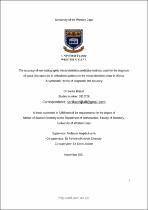| dc.contributor.advisor | Harris, Angela | |
| dc.contributor.author | Brijlall, Sarika | |
| dc.date.accessioned | 2022-03-15T12:20:07Z | |
| dc.date.available | 2022-03-15T12:20:07Z | |
| dc.date.issued | 2021 | |
| dc.identifier.uri | http://hdl.handle.net/11394/8893 | |
| dc.description | Magister Scientiae Dentium - MSc(Dent) | en_US |
| dc.description.abstract | Orthodontic space analysis is a critical component into informing diagnosis and leading to targeted interceptive treatment planning in the mixed dentition stage of tooth development. Accurate and reliable space analysis methods - radiographic and non-radiographic - are beneficial for the early detection of imbalances between the mesiodistal diameter of unerupted permanent teeth and its alveolar bone support, which can contribute significantly in preventing severe malocclusions. Due to the ease and simplicity in its application, the non-radiographic mixed dentition space analysis methods; Moyers, and Tanaka and Johnston; were widely recommended. However, due to these space analysis methods derived from data of a Caucasian European population in the early 1970s, the external validation question, with dubious applicability of these methods in other populations, has been questioned. This has prompted researchers to seek newer, more context-specified prediction tables and equations for specific sample population groups. | en_US |
| dc.language.iso | en | en_US |
| dc.publisher | University of Western Cape | en_US |
| dc.subject | Diagnostic accuracy | en_US |
| dc.subject | Mixed dentition | en_US |
| dc.subject | Tooth size | en_US |
| dc.subject | Orthodontics | en_US |
| dc.subject | Non- radiographic | en_US |
| dc.subject | Africa | en_US |
| dc.title | The accuracy of non-radiographic mixed dentition predictive methods used for the diagnosis of space discrepancies in orthodontic patients in the mixed dentition phase in Africa: A systematic review of diagnostic test accuracy | en_US |
| dc.rights.holder | University of Western Cape | en_US |

